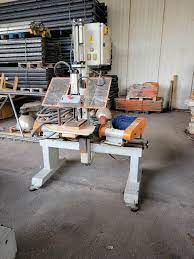Introduction:
In the ever-evolving landscape of machining and fabrication, the demand for versatility and precision is paramount. Universal milling, coupled with the efficiency of hand milling machines, has become a cornerstone in the world of metalworking and material processing. This comprehensive guide explores the intricacies of universal milling and the pivotal role played by hand milling machines in achieving unparalleled precision.
Understanding Universal Milling:
Universal Milling Defined:
Universal milling refers to the process of using a milling machine that can perform a variety of tasks beyond regular milling operations. Unlike specialized milling machines, universal milling machines are equipped with rotary tables that allow for a wide range of cutting angles and positions. This versatility makes them indispensable in industries where precision and adaptability are non-negotiable.
Key Features of Universal Milling Machines:
-
Rotary Tables: Universal milling machines are characterized by their ability to swivel the cutting head and use rotary tables. This feature enables the machining of complex shapes and the creation of intricate designs.
-
Multiple Axes: These machines typically have more than three axes of motion, allowing for simultaneous movement in different directions. This multi-axis capability enhances the overall flexibility and efficiency of the milling process.
-
Interchangeable Tooling: Universal milling machines often support a variety of cutting tools, making them suitable for a wide array of applications. This adaptability is especially valuable in environments where different materials and cutting requirements are common.
The Role of Hand Milling Machines:
Empowering Precision: Hand Milling Machines Unveiled:
Hand milling machines, also known as manual milling machines, are an integral part of the machining landscape. While technology has introduced CNC (Computer Numerical Control) milling machines, hand milling machines remain indispensable for certain applications. These machines are operated manually, allowing machinists to have a hands-on approach to the milling process.
Advantages of Hand Milling Machines:
-
Cost-Effectiveness: Hand milling machines are often more affordable than their CNC counterparts. This cost-effectiveness makes them an attractive option for small businesses and workshops with budget constraints.
-
Simplicity and Versatility: The simplicity of operation is a standout feature of hand milling machines. Machinists can easily control the speed, depth, and direction of the cuts, allowing for precise and customized milling operations. This versatility is particularly valuable when working on one-of-a-kind projects.
-
Skill Development: Operating a hand milling machine requires a certain level of skill and craftsmanship. This hands-on experience contributes to the development of machinists’ skills, fostering a deeper understanding of the milling process.
Applications of Hand Milling Machines in Universal Milling:
In the realm of universal milling, hand milling machines play a crucial role in achieving precision and intricacy. Machinists can use hand milling machines to fine-tune details and make adjustments on the fly. Whether it’s creating custom components or modifying existing pieces, the hands-on control provided by manual milling machines enhances the overall efficiency of universal milling operations.
Choosing the Right Universal Milling Machine:
Factors to Consider:
-
Versatility: Evaluate the range of tasks the universal milling machine can perform. Look for features like rotary tables and multi-axis capabilities to ensure the machine meets the demands of diverse projects.
-
Accuracy: Precision is paramount in universal milling. Consider the machine’s accuracy, spindle speed, and feed rates to determine its suitability for your specific applications.
-
Ease of Use: While universal milling machines are inherently complex, assess the user interface and controls. Intuitive controls can streamline operations and reduce the learning curve for operators.
-
Durability and Maintenance: Universal milling machines are an investment, and their durability is crucial. Additionally, consider the ease of maintenance and the availability of replacement parts.
Conclusion:
In the dynamic world of machining, the synergy between universal milling and hand milling machines is undeniable. The precision and versatility offered by universal milling machines, coupled with the craftsmanship and hands-on control of hand milling machines, create a powerful combination. Whether you are a seasoned machinist or a newcomer to the field, understanding the nuances of these machines is key to unlocking their full potential.
As you embark on your journey into the realm of universal milling, consider the unique features and advantages offered by both universal milling machines and hand milling machine. The marriage of technology and craftsmanship in this field not only shapes intricate components but also paves the way for innovation and excellence in the world of metalworking and material processing.


